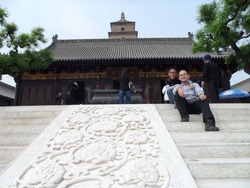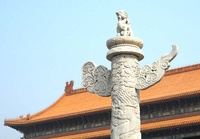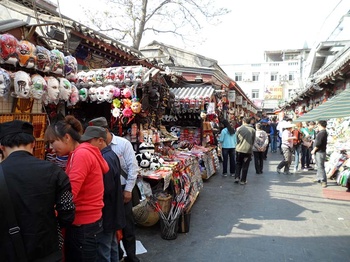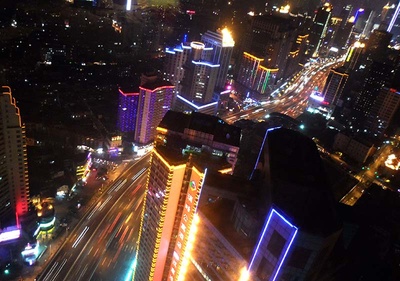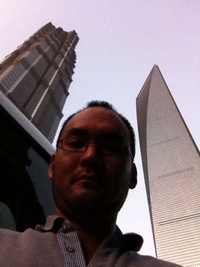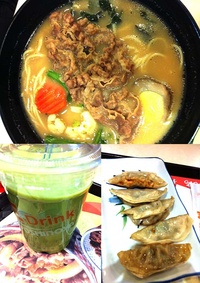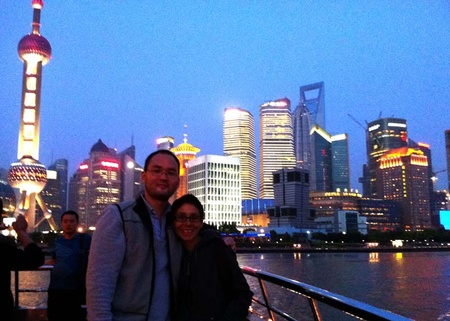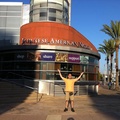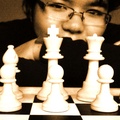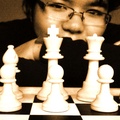Part 2 >>
Xian, second city
They say it is the cultural capital... we can visit the terracotta soldiers who are impressive because there are so many of them; It is a somewhat slow tourist-historical visit, with cold and heavy dissonant architecture contrasted with the historical display of a paranoid emperor buried with his servants and possessions. Impacted by the amount of ceramics.
Continued, eating and eating, more Chinese food at a buffet... it is what in Peru is considered "chifa" although the flavors vary considerably, especially the heaviness in digestion: in Beijing the "traditional" tourist food is light and with subtle flavors , in Xian it is more loaded with a lot of sesame oil that balloons the stomach (gas) and, finally, in Shanghai, it is similar to the Cantonese that swarms throughout our capital city, Lima (with its due generational and fashion transgressions).
Once on the bus, visits to temples are mandatory because they are included in the packages, because they are a tourist attraction, because the good tradition that conditioned people to be patient, observant and live in Acceptance is being lost, letting situations flow and without judge nothing and no one.
Each temple, in each city, has its peculiarity, its symbols, its centuries-old and millennia-old sculptures and buildings and its own interpretations of Life.
Those that were never missing were the Chinese lions and the qilines [shilines] that sometimes serve for security, other times to remember what to do. They are mutants, puzzles with parts of many known animals.
These artistic and artisanal works of ancient heritage are also seen in every commercial place, in every souvenir shop and in markets and of all sizes; The quality of materials varies, the finishes also vary, as happens with all Made in China products, which are the majority of products sold in the world... Chinese communism has seen that the greatest profit is in the volume as they manage their tourist packages. internal and external.
This makes every place bustling with foreigners and provincials, seeking to know, understand, and be filled with the energy of the dragon, an imperial symbol that could only be used by the emperor; Perhaps that is why many Chinese fear the dragon, especially in their year (this year).
But the images that still, after millennia, have a massive reach are the representations of the different gods - who were not bad but, some, had ugly faces to scare away the spirits - and that is why we find them in all the temples that, Additionally, they allow you to enjoy well-designed and well-kept gardens... that is why it is said that the master is born from practice and what is seen says that there are many master gardeners in China, although some do not know how to read or write.
Shanghai, third city visited
At night it is a colorful city because part of the current Chinese philosophy is “to be the best by having the best and doing the best”, evident in the skyscrapers with incredible designs and the gigantic shopping centers.
Ordinary Chinese say that among the skyscrapers they have a “opener”, a “pencil” and a “bottle” is coming in 2013 (it will be the tallest building in the world for some time); and that they are missing a couple of glasses.
About the bottle opener, they told us that it was designed by a Japanese architect who included a “hole” in the head of the skyscraper… the protests changed the shape to an inverted trapezoid (rectangle with a wider top) instead of the circumference that reminds us of the "rising Sun". It is the Shanghai World Financial Center; On its side, another skyscraper, the Jin Mao, with 88 floors (420m) and a spectacular view downwards, towards the hotel lobby inside... from the tourist viewpoint on that 88th floor (they say it is the 5th tallest building of the world).
With this, the Japanese influence in China is notorious and of course, the Chinese influence in Japan and the multiculturalism that every megalopolis experiences.
That is why in this city with 23 million inhabitants, transnational chains have a massive presence: Starbucks is found in every important commercial sector (such as in Manhattan or San Francisco), sportswear and clothing brands are present with their own stores and, added, the Chinese brand Li-Ning of sports clothing and accessories, with more than 2 decades of existence, whose manufacturing quality is very good although the designs can be perfected.
We find these on Nan Jin Street, the most commercial street in the city with thousands of passersby day and night. It is a bit boring for those who do not define themselves through vanity (clothes, accessories... brands to show off) but there is a lot to explore, see, eat.
On an exhaustive walk along this pedestrian street, I found a Japanese fast food restaurant, Yoshinoya, whose signs are scattered throughout Beijing and Shanghai as well as other Chinese cities.
I don't know what I ate because it was in Chinese and the cashier barely spoke English... I remember it had kamaboko, vegetables, udon and an egg skin (if that was what it was); It was accompanied by what I consider to be gyoza and to drink, a matcha ice latte, a drink that reminded me of the matcha yookan and omochi sprinkled with matcha that I ate as a child at my grandmother's house. It reminded me of a flavor that I consider distinctly Japanese.
Imagining another theme, parallel to my grandmother's youth (any of them), 2 generations ago, carriages pulled by a Chinese man swarmed everywhere to transport themselves around the city, but today, that image of the Chinese man with his cigarette in his mouth and a little rounded hat pulling to a tourist couple between alleys saturated with informal vendors and between food stalls and shops, is part of the history that the country sells just as the image of the Incas in Peru and the samurai in Japan is advertised.
There are no longer those forklifts but there are millions of new and many old cars, underground and aerial subways, buses, taxis with taximeters and some companies with their typical liveliness of going around to increase the kilometers traveled, but everyone drives calmly (although in The rest of the world says the opposite.
After comparing it with the vehicular traffic of Lima or Manhattan or Mexico City, it can be said that Chinese drivers are calm even at rush hour, when the travel time is quintupled and even though they themselves say that "after driving in China “You can drive it anywhere in the world,” just as all countries say about their vehicular traffic problems.
I imagine that, if I had driven in China, I would have left several people with pre-heart attacks on the road since it is not similar to how one has to drive in Lima (although today I drive more calmly).
Mixed with cars and buses, transportation by 2 and 3-wheeled motorcycle is very important as well as motorized and pedal bicycles... what must be mentioned is that no one uses safety helmets or other implements against accidents... as a prediction, a Once they get used to vehicle saturation and when the repression of driving rage is endemic, traffic will catch up with the most convulsed cities on the planet.
It is a spectacular trip just as it should be to visit Japan with its history, technology, consumerism and impressive buildings.
Ending the trip
On the last night, a public relations executive at the hotel helped me with the translation of a drink whose label was written entirely in Chinese.
She turned out to be Japanese, from Nagoya, speaking in strange English; We were trying to tell each other our personal stories after learning that the drink was Oolong tea... Japan is very close so much that after having traveled thousands of kilometers, as a Nikkei I can always find something from my roots, the ones that put me in Peru to make my life and reach my goal (independent for each one but involving all of humanity).
My perception of Chinese society has totally changed (I had an old, stereotyped image); Now I say that it is a society that I appreciate for what it shows, for its strength, for its dedication to progress with all that this entails, for its lack of fear in proposing progressive architectures and in using rarely applied technologies, for its cost , in other technologically advanced countries (such as the electromagnetic train –Maglev-, with German technology that has 30km travelable in 14 minutes at 431km per hour at its maximum speed between 3 and 4.30pm because it uses a lot of electricity and this is the time in which more of it is available).
In closing, I am a dragon, I am part of what this year entails. This trip to China was enlightening, renewing, and a very pleasant and memorable experience.
© 2012 Victor Nishio Yasuoka


